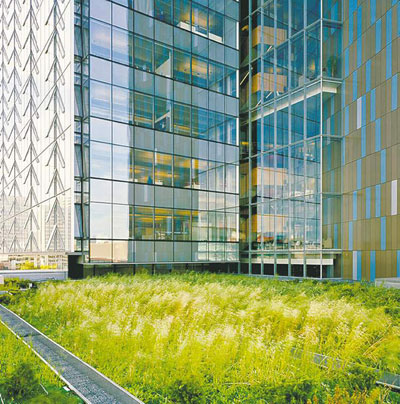 Do you ever wake up in the morning, turn on the weather channel and notice the temperatures shown at The Forks are often several degrees warmer than those at the airport?
Do you ever wake up in the morning, turn on the weather channel and notice the temperatures shown at The Forks are often several degrees warmer than those at the airport?
You wouldn't think an area's climate would change over six kilometres, but it turns out that annually, the average overnight low at The Forks is -0.7 C while at the airport it is almost three degrees colder at -3.4 C. On sunny summer days, the temperature variation between the downtown and the outskirts of the city can reach six or seven degrees Celsius.
The answer to this puzzle is something called the 'urban heat island effect.' As the name suggests, cities are literally islands of heat. A Google Earth view of downtown shows a landscape of black roofs, asphalt streets and concrete sidewalks. These impervious materials absorb and store the sun's energy, releasing it back into the air as heat. Natural landscapes of soil and vegetation trap moisture and use the sun's energy for evaporation, releasing water vapour that cools the air.
For much of the year, heat islands can negatively impact human comfort in the city. This can affect urban vibrancy, commercial activity, public health and air quality while increasing direct energy costs for building owners.
The solution to these issues is to introduce the moderating effect of natural elements back into the urban landscape. Many cities around the world are promoting vegetated or 'green' roofs as a way of managing the quality of their urban environments. Green roofs not only contribute to regulating the microclimate, their social benefits include the reintroduction of habitat for birds and insects, the absorption of pollutants in the air, improved aesthetics and civic image as well as the provision of active public green space.
Modern, lightweight green-roof systems are as little as 15 centimetres deep, appropriate for grasses and lower plantings that can be economically included as part of a new building design or retrofitted onto an existing structure. Costs can be offset for building owners in the long term, because green roofs often last 50 or 60 years, up to three times longer than a typical roof. They also provide significant cooling properties in the summer and improved insulation in the winter, reducing energy demand throughout the year.
In 2003, a study done by the Centre for Indigenous Environmental Resources (CIER) evaluated the benefits of green-roof construction in downtown Winnipeg. Its most significant conclusion was the ability of green roofs to absorb and hold rainwater could make them part of a creative solution to an acute infrastructure challenge facing the city in the coming decades.
Almost 40 per cent of Winnipeg is serviced by a combined sewer system. Found in areas of the city developed before 1960, including all of downtown, combined sewers collect rainwater runoff and the sewage from buildings in a single pipe, which then flows to a treatment facility before being sent into the rivers. During a heavy rainfall or snowmelt, water volumes can exceed the system's capacity, resulting in an increased risk of basement flooding and the discharge of overflow raw sewage directly into the river system. On average, this occurs 18 times per year and results in more than two million litres of untreated sewage being dumped into the Lake Winnipeg watershed annually. The cost of replacing Winnipeg's 1,300 kilometres of combined sewer lines with a two-pipe system would be up to $3 billion.
Instead of shedding runoff into the civic infrastructure, green roofs have the capacity to store nearly 100 per cent of their rainwater, reducing overall volumes in the system. The CIER report used the Assiniboine district (Memorial Boulevard to Main Street and Portage Avenue to the Assiniboine River) as a case study to determine what effects the construction of green roofs would have on stormwater management in a combined sewer-line area.
The results of the study showed if 50 per cent of flat-roof buildings in the neighbourhood were vegetated, overflow volumes into the river would be reduced by 44 per cent every year. When combined with a cost-effective system of increasing storage capacity in the existing infrastructure, the large-scale implementation of green roofs in the city could eliminate overflow events and the need to spend billions of tax dollars replacing the single-pipe system.
In 2010, Toronto became the first city in North America to enact a green-roof bylaw. Green roofs are now required for all new buildings more than 2,000 square metres in area, covering up to 60 per cent of the roof. An incentive program has also been developed to retrofit existing buildings. The result has been more than 100,000 square metres (one million square feet) of green roofs being installed in each of the last two years in that jurisdiction.
In Winnipeg, small installations are happening throughout the city, including at the Qualico Family Centre, Manitoba Hydro Place, Millennium Library Park, Mountain Equipment Co-op and soon the Union Bank Tower. To significantly affect stormwater management in the combined sewer areas of our city however, we will need to develop a holistic plan that follows Toronto's success in finding visionary solutions with greater public benefit than the traditional response of simply building bigger pipes.
A progressive green-roof bylaw and incentive program could be an intelligent investment of tax dollars that makes a meaningful contribution to solving our problems below ground while at the same time enhancing our urban environment above ground.
Brent Bellamy is senior design architect for Number Ten Architectural Group.
Republished from the Winnipeg Free Press print edition October 22, 2012 B4

